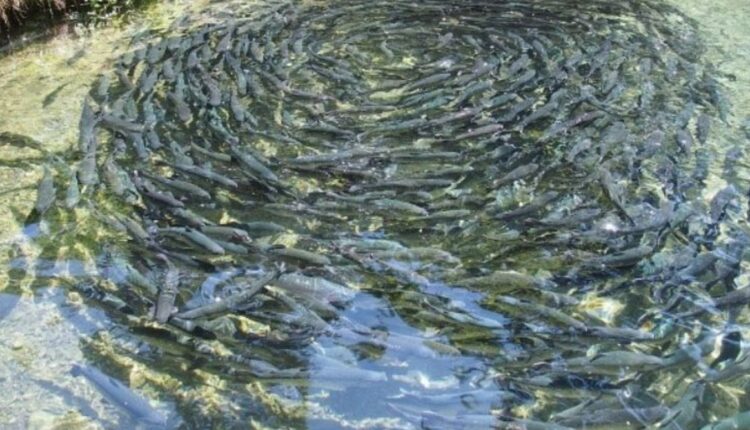Fish Farming In Monsoon: How to do fish farming in monsoon? Know the right care and preparation of the pond
Fish Farming In Monsoon: To get success in fish farming (Fish Farming In Monsoon), timely cleaning and proper preparation of ponds is very important, especially for fish farming in monsoon. During monsoon, the water level rises and there are many changes in the environment, which can affect the health and production of fish. Therefore, it is necessary to clean the ponds and prepare for fish farming before the monsoon. Let us know how to do this work correctly.
Fish farming is an important and profitable business in India. Fish farming provides a means of additional income to farmers and rural families. But to get success in fish farming (Fish Farming In Monsoon), timely cleaning and proper preparation of ponds is very important, especially for fish farming in monsoon. During monsoon, the water level rises and there are many changes in the environment, which can affect the health and production of fish. Therefore, it is necessary to clean the ponds and prepare for fish farming before the monsoon. Let us know how to do this task correctly.
Why is Pond Cleaning Important?
Pond cleaning before monsoon is necessary for fish farming in monsoon due to several reasons:
Dirt, dead plants and other residues can accumulate in the pond with rainwater.
Excess silt (mud) can cause lack of oxygen to the fish.
Aquatic weeds (water hyacinth etc.) and harmful bacteria also grow in the pond.
A clean pond helps in good growth of fish and prevention of diseases.
Process of Pond Cleaning
Pond cleaning for fish farming in monsoon is an important step that lays the foundation of fish farming. To make fish farming successful in monsoon, clean the pond before monsoon in the following manner:
1. Draining and Drying the Pond
First of all, drain the water of the pond completely and let the pond dry in the sun for a few days. This destroys harmful germs and parasites.
2. Removing Sludge
After the pond dries, remove the sludge deposited at the bottom. If the sludge remains in large quantity, it pollutes the water and can harm the fish.
3. Checking Pond pH and Soil Quality
Test the pH of the pond soil. Normally the pH level should be between 6.5 to 7.5. If the pH is unbalanced, add lime to improve it. It is beneficial to add 200-300 kg of lime per hectare.
4. Controlling Pathogens and Parasites
After adding lime, you can add pesticides or bleaching powder (100 kg per hectare) as per requirement in the pond, so that the harmful bacteria and parasites present in the pond are eliminated.
Fish Farming Preparation Before Monsoon
Not only cleaning the pond, but proper preparation is also necessary for fish farming. Let us know what things should be kept in mind in this preparation:
1. Selecting Quality Fish Seed
Select high quality and healthy fish seed (fingerling) for good production. Species like Rohu, Katla, Mrigal are popular according to local climate and market demand.
2. Filling the Pond and Balancing Water Conditions
After cleaning and improvement, slowly fill the pond with clean water. The depth of water should generally be between 1.5 to 2 meters. There should be proper amount of oxygen in the water and the temperature should also be favorable.
3. Use of Fertilizers
Use limited quantity of fertilizers like cow dung, single super phosphate (SSP) and urea to increase natural food (plankton etc.) in the pond. This will provide food to the fish and accelerate their growth.
4. Stocking Fish Seed in Proper Quantity
Put the right number of fish seeds according to the capacity of the pond. Generally, 5000 to 10000 fish seeds can be released in one hectare pond.
Pond and Fish Care During Monsoon
1. Monitoring Water Quality
Due to rain, external dirty water or chemicals flowing from the fields can get mixed in the pond. This can spoil the quality of water. Therefore, check the water regularly and change the water if needed.
2. Strengthen the Pond Embankment
There is a risk of the pond embankment breaking due to heavy rains. Therefore, strengthen the pond embankments and take care that the water does not overflow.
3. Disease Control and Use of Medicines
Due to moisture in the monsoon, the risk of fungal infection or other diseases in fish increases. Therefore, use medicines and chemicals like potassium permanganate from time to time.
Additional Tips for Fish Farming
Use aerators (oxygen providing devices) in monsoon to avoid lack of oxygen in the pond.
Remove water hyacinth and other unwanted water plants from the pond from time to time.
Cut the grass around the pond and keep it clean so that there is protection from insects and snakes.
Conclusion
Cleaning the pond before monsoon and preparing the fish farm well greatly improves the growth and production of the fish. This gives the fish farmers better economic returns. If you take regular care of the pond and take care of the needs of the fish, this business can prove to be sustainable and profitable in the long run.
Contact us – If farmers want to share any valuable information or experiences related to farming, they can connect with us via phone or WhatsApp at 9599273766 or you can write to us at “[email protected]”. Through Kisan of India, we will convey your message to the people, because we believe that if the farmers are advanced then the country is happy.
You can connect with Kisan of India on Facebook, Twitter, and WhatsApp and Subscribe to our YouTube channel.



